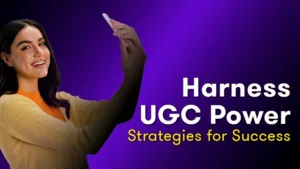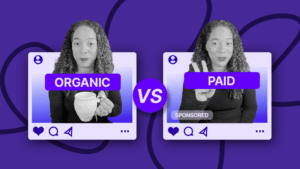UGC Campaign: How Can Brands Harness The Power Of UGC? Strategies For Success
With over 7 years of e-commerce experience, Agne has mastered the balance of creativity and performance. From guiding social media strategies to crafting high-converting ads, she’s all about results.

User-generated content (UGC) is exploding in popularity. Brands are discovering it is a powerful tool to expand their reach and deliver their messages to broader audiences.
And it’s not hard to see why. Forty-three percent of U.S. consumers read online reviews before buying a product while 93 percent of marketers say the UGC outperforms other ad channels.
This post explores how your brand can harness the power of UGC campaigns. We run through everything together, from setting campaign objectives to managing your user-generated content.
What is a UGC Campaign?
A UGC campaign refers to a marketing campaign that is based on user generated content.
Instead of the traditional approach of designing, creating and curating the content that is used in advertising,k UGC campaigns rely on the content created by the target audience of the campaign. This content can be sourced from social media, tool reviews of ordered through UGC platforms like Billo.
Now that we have the idea of what a UGC campaign is, let’s get into more details on how to create one.
Defining Your UGC Campaign Goals: How To Set Objectives That Generate Results
The first step in harnessing UGC’s power is to define your campaign’s goals. Considering what success “looks like” makes it easier to direct your efforts.
For example, you might be looking for:
- Improved engagement – Getting more online users and influencers talking about your products/services
- Brand awareness – Reaching more people and informing them about what you do (particularly if you are new)
- New sales – Encouraging more people to buy from you, including those already interested in your brand
- Repeat sales – Bolstering customer loyalty and encouraging clients to return to you for more services
- Better brand image – Using creators and influencers to adjust how the public perceives you
- Product advertising – Leveraging short-term social outreach to highlight a new release
- Brand partnerships – Working with other companies to increase your business’s reach
During this process, choose the right platforms for your campaign. Don’t just go with the ones you know.
Here’s a rundown of various social media platforms and how you should use them:
1. Facebook
Strengths: Offers various content types such as videos, images, and text. Also, it has community pages for building a “tribe” and facilitating deeper conversations – an excellent channel for forging relationships with UGC creators interested in your brand.
Who’s it for? Firms building communities or offering ecommerce/professional services.
2. Instagram
Strengths: Visual marketing, such as photo and video UGC.
Who’s it for? Suitable for industries that rely on aesthetics to sell their products and services (such as the fashion, travel, and hospitality sectors).
3. X
Strengths: Superior real-time interactions than most social media websites.
Who’s it for? Ideal for customer service, science, news, technology, and brands needing to provide their audiences with regular updates. Offers hashtags and contests for campaign identification and engagement.
4. LinkedIn
Strengths: The world’s biggest network of professionals with tools for sharing industry-related content.
Who’s it for? Suitable for professional services, consultancies, agencies, and firms offering industry insights.
5. Pinterest
Strengths: Highly visual and doesn’t rely on reading skills with in-built purchase options.
Who is it for? Suitable for crafters and DIY hobbyists.
6. TikTok
Strengths: Popular platform with a younger audience. UGC often goes viral within hours.
Who is it for? Suitable for brands focusing on younger consumers
When deciding on a platform, always consider your audience’s demographics. Don’t try to target pensioners on TikTok!
Also, match the UGC content type to the platform. Use highly visual services, like Instagram, for video, and more academic sites, like X, for written content.
Lastly for this section, choose channels that align with your objectives. Instagram is ideal for branding, while X is better for conversions.
Crafting A Compelling UGC BluePrint: Strategies That Work
Once you flesh out your objectives, the next step is to create your UGC.
Most companies start with the basics – photos, videos, and reviews. However, you could experiment with other approaches if they’d help you. For example, phone case manufacturer OtterBox challenged its creators to drop phones using its products from a height to market their indestructibility. It was high-risk, high reward.
Next, look for ways to encourage UGC creator participation. Leverage incentives to get them pumped about taking part. You could try things like:
- Sending personalized thank-you notes to everyone who produces content on behalf of your brand
- Using social proof, such as past reviews from previous UGC drives and how much participants enjoyed them
- Showcasing UGC content on your website while highlighting creators’ personal experiences
- Using gamification to encourage participants to compete with each other
- Building groups and communities where creators can share their ideas and content
- Leveraging professional influencers to communicate with new audiences
- Hosting live events where participants can submit their content in real-time
- Organizing virtual meetups or Q&A sessions where people can ask questions
- Offering vouchers or loyalty points to participants
- Making your campaign sound as exciting as possible to get people more interested in taking part
- Promising to highlight outstanding contributors on your Facebook or Instagram pages
- Offering prizes and giveaways for top content you love
Proven Tactics For Promoting Your UGC Campaign
Once you have your UGC blueprint worked out, the next step is to promote your campaign. Getting the message to people who matter boosts engagement and drives success.
Start by leveraging social media itself. Announce your campaign on these platforms and what you want participants to do. Tell creators if you plan on rewarding them in some way for their efforts.
You could also reach out to people on your email list. Subscribers can provide a head start and give you content you can work with immediately.
Paid advertising can also work if you don’t have much traction on social media yet. Choose demographics you think will respond positively to your ideas but be careful not to overspend.
Finally, consider partnering with influencers and brand ambassadors. These individuals can create and drive UGC production. For example, you could get your brand partners to produce content and send out requests to their audience to do the same, promising to repost their best efforts on their channels.
Managing and Curating UGC Campaigns Like A Pro
Once content starts flowing, monitor submissions for quality. Check you are getting the results you want.
Most brands curate their UGC, picking the best content for their advertising and promotions. Some will be exceptional, showing your product in full glory, while others will disappoint, with bad lighting and narration.
If you don’t have sufficient UGC for your campaign, you can ask contributors with low-quality user-generated content to try again. Often, results the second time around are better if you tell them how they can improve.
Explore successful UGC campaign examples for inspiration
Legal Considerations: What To Watch Out For
UGC campaigns seem straightforward. But you must still take care to avoid falling foul of the rules.
First, you should obtain written consent from creators to use their content. Ideally, get them to sign a formal agreement form.
Completing this document is essential because it protects you against future claims. If you don’t obtain the proper legal paperwork, it can create issues.
Next, be sure to avoid copyright infringement. Always check the UGC is free from restricted material (like pop songs) unless you have commercial permission to use it.
Pay attention to third-party brand logos and images in the content. Again, using these could land you in trouble.
Platform Rules
Most platforms also have various compliance policies you must follow. These include user privacy and data protection, content moderation, and disclosure requirements.
Read through the rules if you plan on sharing UGC on Facebook, TikTok, and Instagram. Always apply content moderation policies to ensure user-generated content is compliant (to avoid strikes against you).
Measuring and Analyzing The Success Of Your UGC Campaign
Finally, you should measure and analyze your campaign’s success to see whether it was worth it. (Usually with UGC, it is!)
The key metrics to track include:
- Engagement
- Reach
- Conversions
- Return on investment (ROI)
- Return on ad spend (ROAS)
- Click-through-rate (CTR)
Collecting this information provides insights into how you should conduct future campaigns. It tells you what to do next and how to change your approach.
Engagement, for instance, matters because it tells you if your content resonates with your audience. It indicates whether it’s compelling or you need to try a different approach.
Try-on hauls for fashion brands are usually low-engagement – everyone’s doing them. By contrast, clothing recommendation videos tend to do better.
Reach is another metric to track. It matters because it reveals how far your content is spreading. (The further, the better). The metric reveals if you are exposing your brand to wider audiences or stuck in a rut. You can see if your return on investment (ROI) is acceptable or whether you should change tack.
Even click-through rates (CTRs) could be valuable. These tell you whether your UGC is compelling and users want to learn more. You can use them to understand how content drives traffic to your website so you know formats to target in the future.
Learn more about maximizing performance with UGC video editing.
Tools For Measuring Success
Once you collect these UGC metrics, the next step is to evaluate them.
Most social media platforms have native tools you can use, like X Analytics and Facebook Insights. These provide reporting information on most (if not all) metrics listed in the previous section.
Google Analytics is even more comprehensive. It can measure ROI and other variables to provide deeper insights into campaign success.
These tools are helpful because they let you:
- Improve campaign timing (making it more seasonal or posting at specific times of day)
- Identify what makes campaigns successful so you know what to do next time
- Compare your UGC campaigns to determine the features that suggest greater impact
Experiment with using these tools to get a clearer view of how your UGC campaign is progressing. Keep circling back to them every week to monitor any changes.
Ready to launch your UGC campaign?
Explore Billo creators to find the perfect fit.
Creative Manager
With over 7 years of e-commerce experience, Agne has mastered the balance of creativity and performance. From guiding social media strategies to crafting high-converting ads, she’s all about results.

Authentic creator videos, powered by real performance data
22,000+ brands use Billo to turn UGC into high-ROAS video ads.
Common UGC Brief Mistakes Brands Still Make in...
A vague or overpacked brief derails campaigns before they start, [...]...
Read full articleOrganic UGC vs Paid UGC: How Top Brands Drive Gr...
More brands are turning to user-generated content (UGC) to fuel [...]...
Read full articleOrganic UGC: How to Turn Native Creator Posts in...
Short-form feeds spotlight content that feels natural, not like ads. [...]...
Read full article



